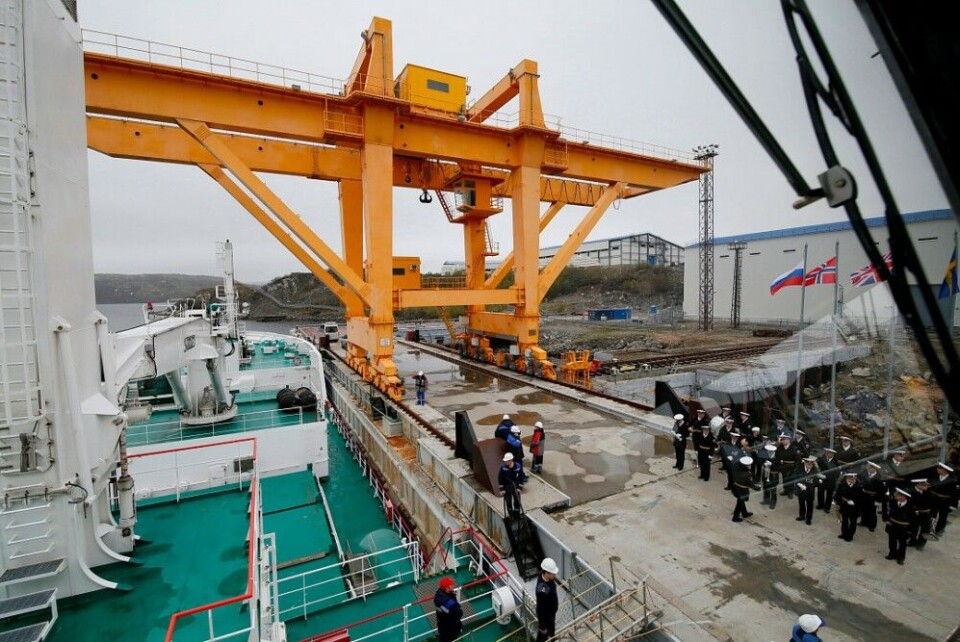
Norway celebrates 25-years paying for nuclear-dump cleanup. Russia showcases new reactor weapons
Rosatom officials and Norwegian project partners are Wednesday marking that it is 25 years since the first money check was sent from Oslo to help improve infrastructure at the ill-fated Andreeva Bay dump site for spent nuclear fuel and radioactive waste accumulated from the operation of Cold War submarines.
Hindered from on-site meetings due to the pandemic, today’s 25-years anniversary meeting in Andreeva Bay is long overdue. However, the meeting comes in pole position as the two countries are trying to improve bilateral relations in times of more complex geopolitics and higher tensions between NATO and Russia up north.
Wednesday morning, in the waters northwest of Andreeva Bay, the Norwegian Coast Guard vessel “KV Nordkapp” welcomed the Russian FSB Coast Guard vessel “Polyarnaya Zvezda” on the maritime borderline in the Varanger fjord. Onboard are top uniformed officials sailing to port in Kirkenes for bilateral talks on joint practical challenges in the Barents Sea that the two countries will solve in cooperation. Fisheries inspections and search-and-rescue preparedness are two areas where cooperation goes on without being too much troubled by colder east-west tensions.
Likewise, ensuring nuclear safety is another topic for good bilateral cooperation.
For the Soviet nuclear navy, the Coastal Technical Base in Andreeva Bay became the main storage site for both spent fuel assemblies from submarine reactors, as well as a site to store containers with solid radioactive waste. Focus was not on safety and after years of exposure to Arctic climate, the site became contaminated and the infrastructure started to fall apart. With Russia being broke after the collapse of the Soviet Union, the call for international action was precarious. Norwegian money, and will to solve the problem, was most welcomed.
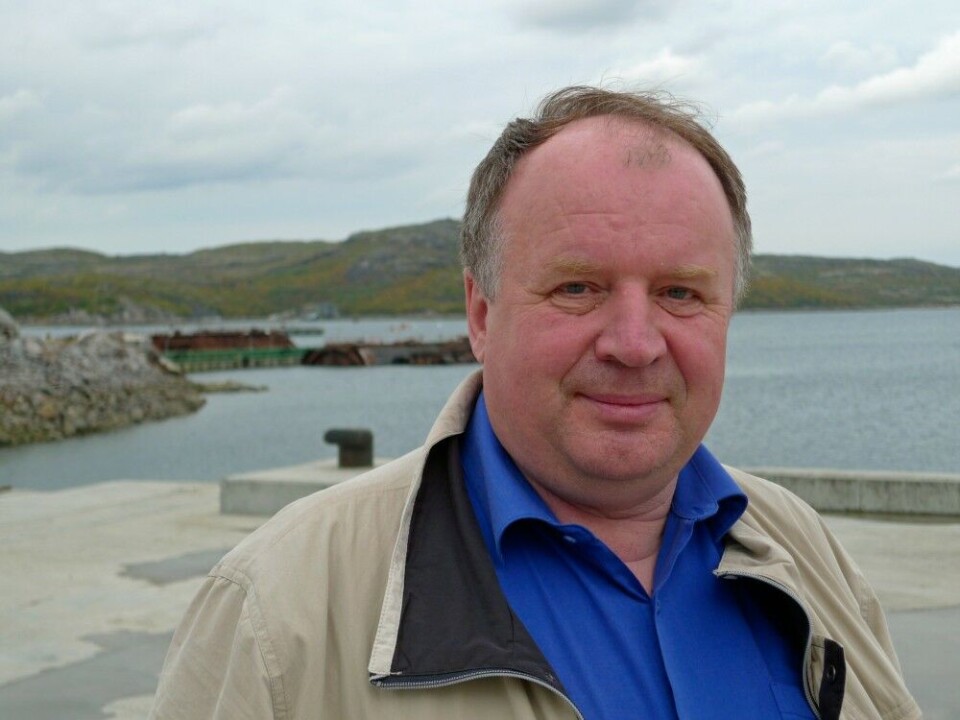
On the regional level, the County Governor of Finnmark was assigned the task to bring over the money and make sure plans and schedules were followed in line with agreements under the Norwegian-Russian Commission on Nuclear Safety. Chief engineer Per-Einar Fiskebeck with the County Governor’s administration has led the implementation for the last 25-years. He is present at celebrations in Andreeva Bay on September 29. Improving infrastructure at the dump-site, along with decommissioning of five Cold War submarines, are considered the most successful project cooperation Norway and Russia have carried out up north in modern times.
Success story
More than 2 billion kroner (nearly €200 million) of Norwegian taxpayers money are spent on helping Russia secure its nuclear legacy since the mid-1990ties. The ground-breaking nuclear safety work initiated on the Kola Peninsula, only some 60 km from the border to Norway, has since been followed by many other countries and international financial grant programs.
Sergey Dubovoy, Chairman of Murmansk regional Duma, praises the joint work by Norway and Russia in Andreeva Bay.
“For a quarter of a century of cooperation within the framework of the Nuclear Safety Program, our countries have done a tremendous job. Andreeva Bay is turning into a unique centre for radioactive waste management, experience in handling spent nuclear fuel that has been accumulated. This has no analogues in the world,” Dubovoy said in a statement posted on the Duma’s portal.
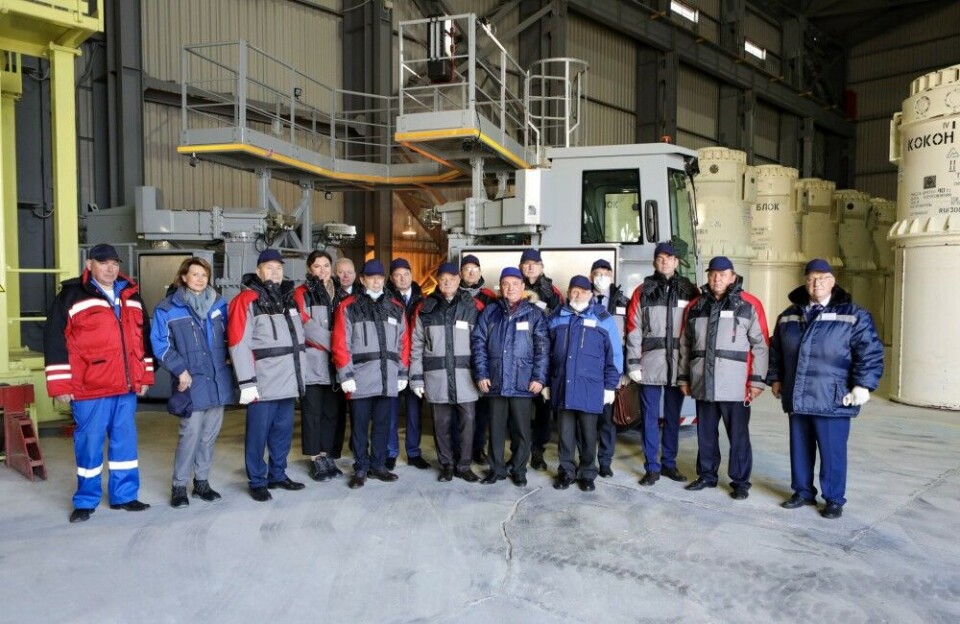
For projects in Andreeva Bay, Norway has paid more than €30 million on things like fixing electricity, water pipelines, roads, fences, constructing a new sanitary building and improving the old pier in port with a new lifting crane. About half of the 21,000 spent uranium fuel elements originally stored in three rundown concrete tanks is so far lifted out, repacked and shipped out of Andreeva Bay. First to Atomflot in Murmansk, then by train further to Russia’s reprocessing plant at Mayak in the South Urals. Some 10,000 cubic meters of solid radioactive waste that previously was stored outdoor and exposed to snow and frost is now under roof in a new building erected at the site. Soon, also that will be transported away.
Present at the celebrations in Andreeva Bay is also representatives from the environmental NGO Bellona. It was this organization, with offices both in Murmansk and Oslo, that before the official country-to-country cooperation started, was first to uncover security breaches and the urgency to act before the entire storage site turned out to be a Chernobyl in slow-motion.
“Time has come”
Bellona’s Aleksandr Nikitin says to the Barents Observer that the time has come for Russia to solve its own nuclear challenges, not the international community. “But first we have to complete already started international projects, like the nuclear legacy,” Nikitin says and points to the ongoing work in Andreeva Bay.
“The situation in Russia is not like it was 25 years ago. New challenges created by Russia should first of all be tackled by Russia. The international community should just check that the new sites do not end up in a situation as previously happened 25 years ago at sites like Andreeva Bay and Gremikha,” Nikitin argues.
“Russia should invest and improve its storage sites.”
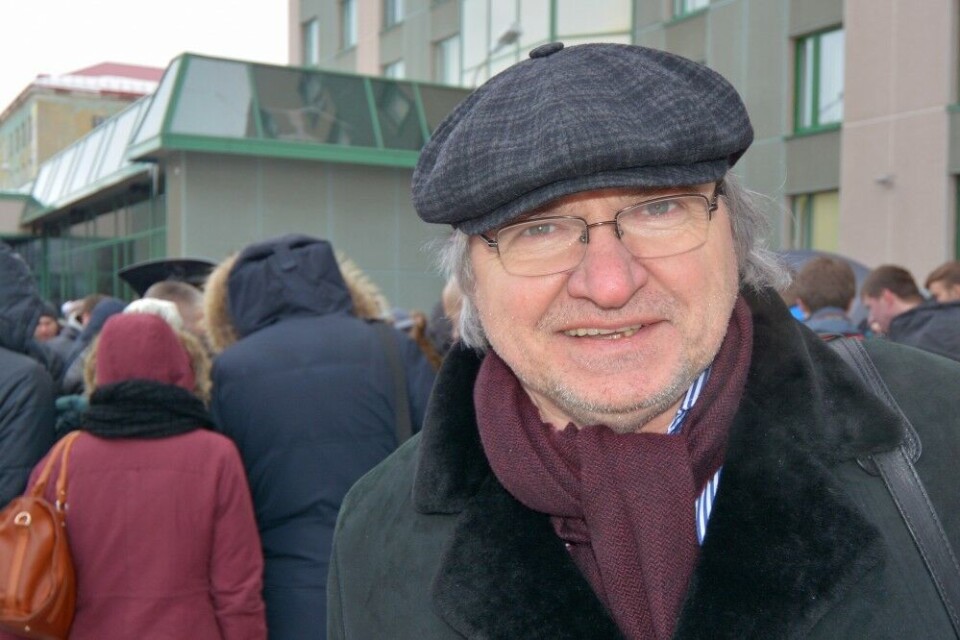
Meanwhile, and unlike the 1990ties, Russia is now investing huge money in building new nuclear-powered submarines and other military nuclear installations. A key question is whether Moscow now is arming the country again into a nuclear age that later could cause similar radiological waste challenges as the legacy from the last Cold War created.
“This question is often discussed on all levels,” Nikitin explains. Additional to his work with Bellona, he is head of the Environmental Commission of the Public Council of Rosatom, Russia’s state nuclear corporation.
“I hope that the system will take care of the future nuclear legacy without waiting for it to be accumulated. Nuclear and radioactive waste should be dealt with before it reaches a situation as we had in Soviet times,” Nikitin says.
“It is a task for Russia and Rosatom. We cannot hire anymore for a rich uncle from the west to come and help again. It was a time when it was necessary, not anymore.”
Meanwhile, Aleksandr Nikitin is glad to see the solution-oriented results of the work in Andreeva Bay.
“Bellona started it, and we have to finish it,” he says.
Sunken reactors
Andrey Zolotkov with ANO Bellona Murmansk says there are problems in the sphere of nuclear safety that Russia can’t deal with alone.
“This is to raise the sunken nuclear submarines,” he says.
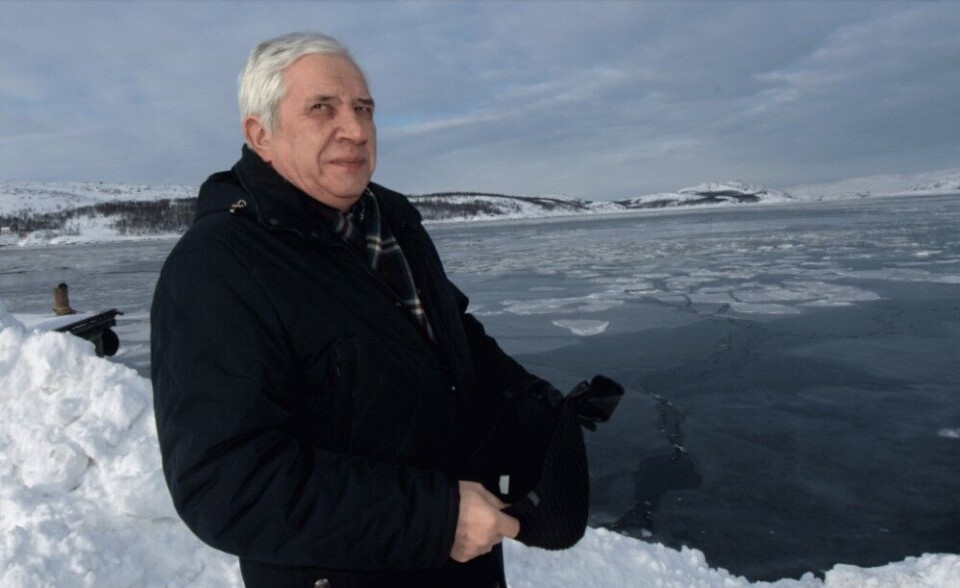
On the seafloor of the Barents Sea, the old November class K-159 that sank in August 2003 has two reactors with spent nuclear fuel on board. The submarine lays in an area of high importance for the fisheries of both Russia, Norway and the European Union. Further east, in the Kara Sea, the submarine K-27 was dumped on purpose, along with several other submarine reactors and thousands of containers with radioactive waste.
Zolotkov fears the submarines may corrode to the worse if nothing is done.
“If we constantly postpone this for later, then something may happen. The lifting operation will sooner or later become impossible because supporting structures will be destroyed as a result of corrosion.”
A key question is how eager potential donor nations would be to cash out even more money to assist in reducing the environmental risks caused by the past nuclear legacy, like the dumped reactors in the Kara Sea, as long as Russia itself gives priority to creating nuclear weapons systems beyond what the world ever has seen before.
Rearmament of the north
Russia’s rearmament of the north includes a new generation of both multi-purpose submarines and ballistic missile submarines. Currently, some 12-13 reactor-powered subs are under construction at the Sevmash yard in Severodvinsk. The new vessels will sail for both the Northern Fleet and the Pacific Fleet. Little is known about 4th generation Russian navy reactors and uranium fuel enrichment.
Maybe more frightening than the new submarines are two other reactor-powered weapons systems currently under testing and development in northern Russia: the Poseidon underwater drone and the Burevestnik cruise missile. Both are said to carry nukes and have a nearly unlimited range.
New satellite images
In late August, Google Earth updated its satellite images from above the naval yards in Severodvinsk. Along the harbor front on the Zvezdockha side of the waters, a new facility and pier are built. Like intended for space photos, one Poseidon drone, one canister for the drone and one transport cask are displayed side-by-side. The special-purpose ship “Akademik Aleksandrov” is portside, also with a Poseidon-look-a-like structure attached in the rear. The vessel is sailing for GUGI, the Main Directorate for Deep-Sea Research, a top-secret unit directly subordinated the General Staff of the Russian Armed Forces. From this center in Severodvinsk, Russia’s seabed warfare capabilities are conducted. Unlike other harbor fronts inside the Sevmash and Zvezdockha, the facility has a special barbed wire fence around, also visible on Google Earth’s satellite images.
The satellite findings were first reported in an article posted by U.S. Naval Institute. How, when, and where in the White Sea, Barents Sea region the nuclear-powered underwater drone Poseidon is tested is of course keeps secret. But testing goes on, which has been confirmed by President Putin himself.
The nuclear-powered “Belgorod” (K-329) submarine, also designed for GUGI, started sea trials in the White Sea in June this year. Since then, the vessel, which is said to be the first real carrier of the Poseidon drone, has been to sea for most parts of July and August.
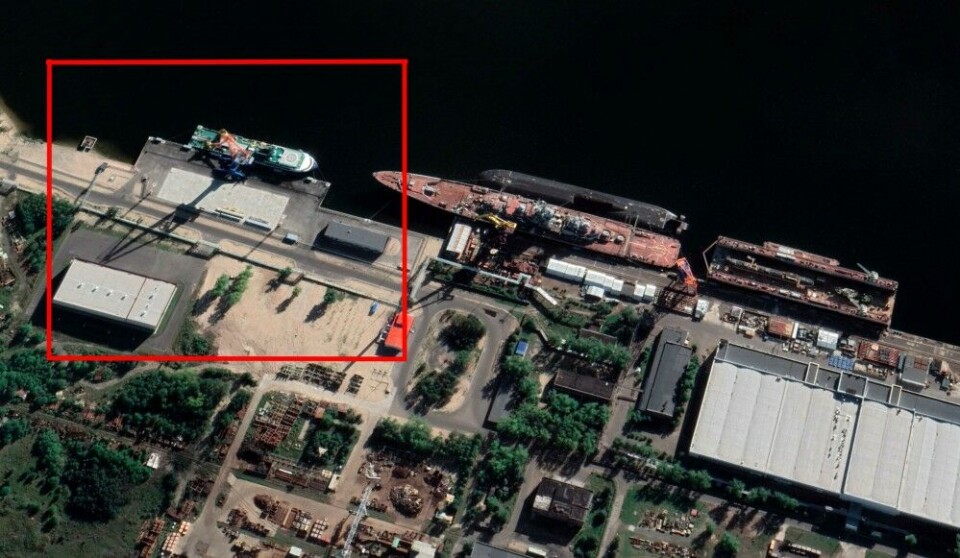
Nenoksa accident
In August 2019, five employees from Rosatom were killed when a nuclear object was about to be raised from the seabed outside Nenoksa in the White Sea, only a few kilometers west of Severodvinsk. What exactly happened remains secret, but radiation monitors in Severodvinsk saw a spike, and locals took photos of ambulances where both the interior and the drivers were wearing protective dressed against radiation.
As reported by the Barents Observer, the explosion was most likely involving the reactor from a Burevestnik test. This autumn, Russia’s top-secret testing of the Burevestnik nuclear-powered missile is moved to Novaya Zemlya in the Arctic, an archipelago under full military control and formerly used for real nuclear weapons tests in the atmosphere and underground.
This week, a large area both on land at Novaya Zemlya and in the waters along the west coast on the Barents Sea side is closed off with NOTAM-warnings (Notice to Airmen). The size of the closed-off areas fits with a likely test launch of the nuclear-powered missile.
Very intriguing NOTAM, covering most of Novaya Zemlija and water to the west.Do we get 9M730 Burevestnik tests this time?Thanks to @dbmee for pointing at these. pic.twitter.com/8rnJsfM1vw
— The Lookout (@The_Lookout_N)
A Norwegian intelligence official has previously expressed fears for more accidents with the reactor-powered weapons systems now under testing and development in Norway’s neighboring areas up north.
For Norway, a challenge is to balance the aid-support to nuclear safety with making sure no funding ends up in Russia’s new crazy nuclear weapons programs.
That balance is not always easy. In 2019, Rosatom’s special vessel “Serebryanka” had a key role in the recovering operation after the explosion involving a weapon reactor for the Burevestnik missile in the White Sea. The same vessel, which has license to transport and handle nuclear fuel and radioactive elements, was also spotted west of Novaya Zemlya in the period between November 2017 and February 2018, a period when the Burevestnik missile was tested from the Pankovo site and allegedly crashed in the Barents Sea.
The “Serebryanka” dilemma
A review made by the Barents Observer of the publicly available documents on financial aid from Norway and Sweden to equip modern communication and positioning systems on board “Serebryanka” shows that about 9 million kroner (€900,000) were spent on the project in 2013 and 2014. That was shortly before the Burevestnik testing program started.
The Swedish Radiation Safety Authority, in charge of the project, says in its annual overview of Non-Proliferation cooperation for 2013 that the “Serebryanka” was the largest project initiated in the Murmansk region.
Stockholm spent 4,1 million Swedish kroner (SEK) on equipment for “Serebryanka” in 2013 and an additional 217,000 SEK in 2014.
Describing the project, the Radiation Safety Authority writes: “This project is co-financed with Norway and the purpose is to equip the vessel “Serebryanka” with a physical protection system, as well as communications and positioning systems, in order to increase security when transporting nuclear materials and radioactive substances.”
The Norwegian share of the project was 3 million Norwegian kroner, paid as part of the Nuclear Action Plan financed by the Ministry of Foreign Affairs.
Conflict-of-interests
Asked about the potential conflicting interests, State Secretary Audun Halvorsen in Norway’s Foreign Ministry told the Barents Observer upfront of the annual meeting in the Norwegian-Russian Commission on Nuclear Safety this spring that “…. our bilateral cooperation on nuclear safety projects are related to civilian activities only, and questions regarding military activities are therefore considered outside of the scope of the commission by the Russian side.”
Halvorsen said the ship plays an important role to eliminate threats from nuclear waste storage sites. “The Serebryanka is specifically designated for transportation of spent nuclear fuel and radioactive waste. As such, this ship is important for the work done to eliminate threats from material stored under severe conditions at naval bases and storages facilities in northwest Russia. This is the reason why Norway and Sweden decided to co-fund a limited project to enhance physical protection at the Serebryanka amounting to 3 million kroner.”
“Norwegian policies under the Government’s Action Plan for Nuclear Safety and Security are well known by our Russian counterparts, and we communicate them clearly in the annual meetings of the joint Nuclear Commission.”
Asked about how Norway makes sure no projects financed by the country do not contribute to improvements or maintenance of military reactors or nuclear weapons systems, Audun Halvorsen answered evasively: “Norwegian goals and policies for the cooperation on nuclear safety are clearly set out in the Government’s Nuclear Action Plan. The projects funded under the action plan are specifically designed to contribute to the realization of these goals. Norway continues to follow closely the implementation of these projects in order to ensure that their impact is in line with our intentions.”

















